
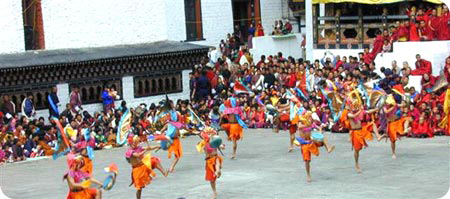
Bhutan Religion - Bhutan Festivals and Dates
To attend a festival is to be blessed. The timing has also been set ingeniously after the harvest so that people can also celebrate a year of working hard in the fields.
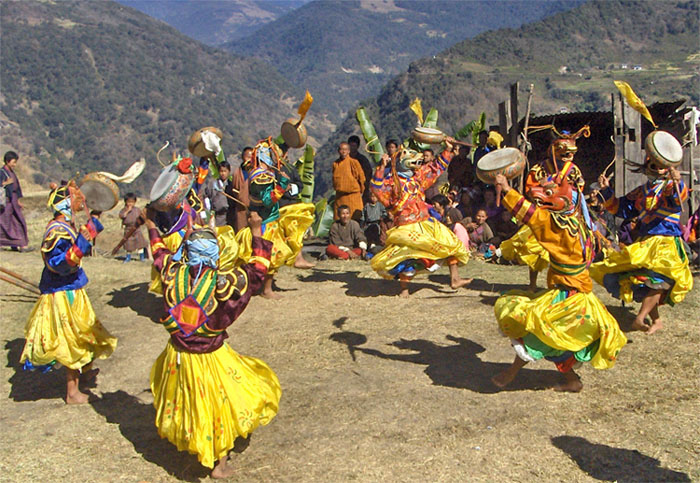
Bhutan Rebirth has a wide range of activities specially designed for visitors- to enjoy tours, treks and cultural events. Information can be sought from us as to which particular festival, tour or trek will be of interest to the clients. Please click here for Bhutan Rebirth's Package Festival Tours.
Based on the dates of the festivals you are interested in (given below) and the other places you wish to visit, we can work out an itinerary to fit the dates in combination with other tours. All you have to do is email us at bhutanrebirth@gmail.com.
For Clients traveling in peak season and Festivals time, it is necessary to book the Tour at least 2 1/2 months in advance. Festivals held in autumn and spring are peak time for tourists and without early reservation it can be difficult to confirm flights and hotels.
BHUTAN FESTIVAL DATES 2019-2020
| FESTIVAL | PLACE |
DATES |
| PUNAKHA DRUBCHEN | PUNAKHA | 6th – 10th Mar 2019 |
| PUNAKHA TSHECHU | PUNAKHA | 11th – 13th Mar 2019 |
| CHHORTEN KORA | TRASHIYANGTSHE | 16th Mar & 30th Mar 2019 |
| GOMPHUKORA | TRASHIGANG | 7th – 9th Apr 2019 |
| PARO TSHECHU | PARO | 11th – 15th Apr 2019 |
| CHHUKHA TSHECHU | CHHUKHA | 13th – 15th Apr 2019 |
| URA YAKCHOE | BUMTHANG | 10th – 14th May 2019 |
| NIMALUNG TSHECHU | BUMTHANG | 5th – 7th July 2019 |
| KURJEY TSHECHU | BUMTHANG | 7th July 2019 |
| TOUR OF THE DRAGON (BICYCLE RACE) | BUMTHANG TO THIMPHU | 6th Sep 2019 |
| THIMPHU DRUBCHEN | THIMPHU | 28th Sept. – 2nd Oct 2019 |
| WANGDUE TSHECHU | WANGDUEPHODRANG | 1st – 3rd Oct 2019 |
| TAMSHING PHALA CHHOEPA | BUMTHANG | 2nd – 4th Oct 2019 |
| THIMPHU TSHECHU | THIMPHU | 3rd – 5th Oct 2019 |
| GASA TSHECHU | GASA | 3rd – 5th Oct 2019 |
| THANGBI MANI | BUMTHANG | 7th – 9th Oct 2019 |
| JAMBAY LHAKHANG DRUP | BUMTHANG | 6th – 10th Nov 2019 |
| PRAKHAR DUCHHOED | BUMTHANG | 7th – 9th Nov 2019 |
| BLACK NECKED CRANE FESTIVAL | WANGDUEPHODRANG | 11th Nov 2019 |
| MONGAR TSHECHU | MONGAR | 28th Nov. – 1st Dec 2019 |
| TRASHIGANG TSHECHU | TRASHIGANG | 29th Nov. – 2nd Dec 2019 |
| NALAKHAR TSHECHU | BUMTHANG | 6th – 8th Dec 2019 |
| DRUK WANGYEL TSHECHU | DOCHULA, THIMPHU | 13th Dec 2019 |
| TRONGSA TSHECHU | TRONGSA | 30th Dec 2019 – 1st Jan 2020 |
| LHUENTSE TSHECHU | LHUENTSE | 30th Dec 2019 – 1st Jan 2020 |
Bhutan Festivals Schedule & Dance Sequence:
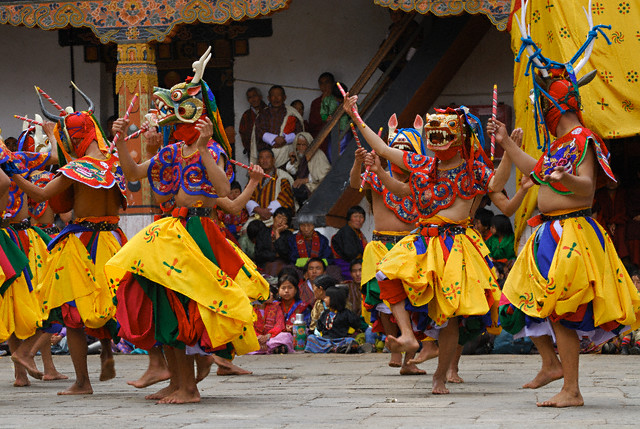 The
dance schedule for each day of the four day festival is set out and generally
consists of the following dances:
The
dance schedule for each day of the four day festival is set out and generally
consists of the following dances:
• Day 1: the performances cover: Dance of the Four Stags (Sha Tsam);
Dance of the Three kinds of Ging (Pelage Gingsum); Dance of the Heroes
(Pacham), Dance of the Stags and Hounds (Shawo Shachi) and Dance with
Guitar (Dranyeo Cham).
• Day 2: On the second day the dances performed are: The Black Hat
Dance (Shana), Dance of the 21 black hats with drums (Sha nga ngacham),
Dance of the Noblemen and the Ladies (Pholeg Moleg), Dance of the Drums
from Dramitse (Dramitse Ngacham), Dance of the Noblemen and the Ladies
(Pholeg Moleg) and Dance of the Stag and Hounds (Shawa Shachi).
• Day 3: the dances performed are: Dance of the Lords of the Cremation
Grounds (Durdag), Dance of the Terrifying Deities (Tungam) and Dance of
the Rakshas and the Judgement of the Dead (Ragsha Mangcham).
• 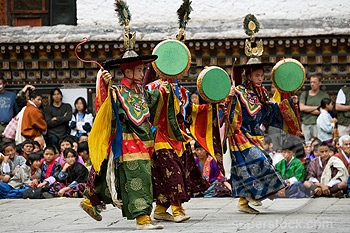 On
the last day of the festival, the dances performed cover: Dance of Tamshing
in Bumthang, Dance of the Lords of the Cremation grounds (the same dance
as day 3), Dance of the Ging and Tsoling (Ging Dang Tsoling) and Dance
of the Eight Manifestations of Guru Rinpoche (Guru Tshen Gye). The last
day of the four day festival also marks the unfurling of the Thongdrel,
a very large scroll painting or thangka, which is unfurled with intense
religious fervour, early in the morning. This painting measuring 30 metres
(98 ft) × 45 metres (148 ft) has the images of Padmasambhava at
the centre flanked by his two consorts and also his eight incarnations.
Devotees who gather to witness this occasion offer deferential respect
in front of the Thongdrel seeking blessings. Folk dances are performed
on the occasion. Before sunrise, the painting is rolled up and kept in
the Dzong before it is displayed again one year later.
On
the last day of the festival, the dances performed cover: Dance of Tamshing
in Bumthang, Dance of the Lords of the Cremation grounds (the same dance
as day 3), Dance of the Ging and Tsoling (Ging Dang Tsoling) and Dance
of the Eight Manifestations of Guru Rinpoche (Guru Tshen Gye). The last
day of the four day festival also marks the unfurling of the Thongdrel,
a very large scroll painting or thangka, which is unfurled with intense
religious fervour, early in the morning. This painting measuring 30 metres
(98 ft) × 45 metres (148 ft) has the images of Padmasambhava at
the centre flanked by his two consorts and also his eight incarnations.
Devotees who gather to witness this occasion offer deferential respect
in front of the Thongdrel seeking blessings. Folk dances are performed
on the occasion. Before sunrise, the painting is rolled up and kept in
the Dzong before it is displayed again one year later.
Cham dance
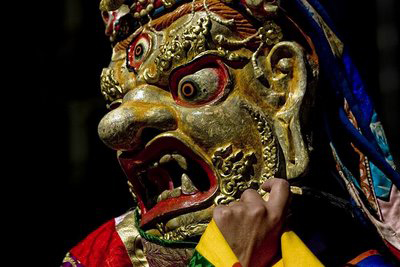 The cham dance, is a lively masked and costumed dance associated with
some sects of Buddhism, and is part of the Buddhist festivals. The dance
is accompanied by music played by monks using traditional Bhutanese and
Tibetan instruments. The dances often offer moral instruction relating
to compassion for sentient beings and are held to bring merit to all who
perceive them. Cham dances are considered a form of meditation and an
offering to the Gods. The leader of the cham is typically a musician,
keeping time using some percussion instrument like cymbals, the one exception
being Dramyin Cham - where time is kept using dramyin. Chams often depict
incidents from the life of Padmasambhava, the 9th century Nyingmapa teacher
and other saints. In Bhutan, the dances are performed during an annual
religious festival (Tsechu) which is held in each district. Only monks
or male members of the Royal Academy of Performing Arts are allowed to
perform a cham dance in Bhutan.
The cham dance, is a lively masked and costumed dance associated with
some sects of Buddhism, and is part of the Buddhist festivals. The dance
is accompanied by music played by monks using traditional Bhutanese and
Tibetan instruments. The dances often offer moral instruction relating
to compassion for sentient beings and are held to bring merit to all who
perceive them. Cham dances are considered a form of meditation and an
offering to the Gods. The leader of the cham is typically a musician,
keeping time using some percussion instrument like cymbals, the one exception
being Dramyin Cham - where time is kept using dramyin. Chams often depict
incidents from the life of Padmasambhava, the 9th century Nyingmapa teacher
and other saints. In Bhutan, the dances are performed during an annual
religious festival (Tsechu) which is held in each district. Only monks
or male members of the Royal Academy of Performing Arts are allowed to
perform a cham dance in Bhutan. Please click here for Bhutan Rebirth's Package Festival Tours.
